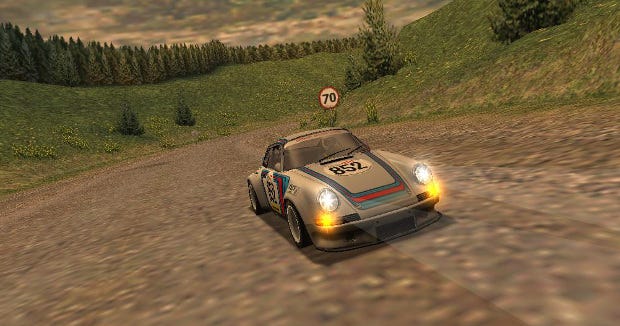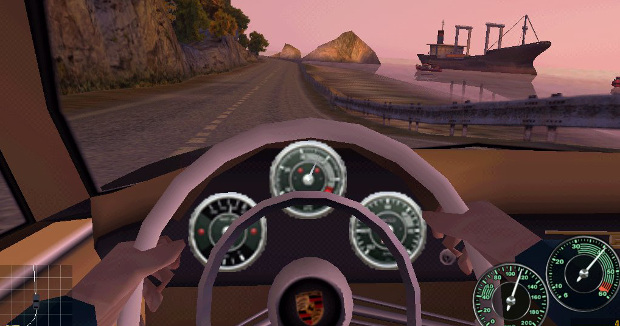Need for Speed: Porsche Unleashed Is The Game Most Worth Saving From 2000
Saved Games: a retrospective series.
Every game released before 2005 is being destroyed. We only have time to rescue one game from each year. Not those you've played to death, or the classics that the industry has already learned from. We're going to select the games that still have more to give. These are the Saved Games.
I remember when the Porsche 911 arrived on the scene in 1963.
Which is strange because I wouldn't even be born for a couple more decades, but nevertheless I have a strong memory of what it was like when the very first edition of what became the single most successful line of sports cars ever produced first appeared. The reason I remember this moment is because I felt like I lived it in 2000's Need for Speed: Porsche Unleashed.
Porsche Unleashed is a racing game that I sometimes worry I must have hallucinated because nobody else seems to recall it. Certainly not anyone at Electronic Arts, who have never made a game remotely similar to Porsche Unleashed in 20 years of experimenting with the Need for Speed formula. Even the broader racing game community seems to ignore it. In sim forums where virtual monuments are built to historical classics like Grand Prix Legends, GT Legends, or rFactor's vintage racing mods, Porsche Unleashed already seems to have vanished from memory. Too bad, because if you were lucky enough to have played it, Porsche Unleashed had more character and told a better story than any other racing game since.
Porsche Unleashed was, of course, a celebration of the Porsche auto company, and could easily have been nothing more than licensed car propaganda. That was my fear, certainly, as someone who had never been the least bit moved by Porsche's predictable and repetitive car styling. In my childhood Matchbox car collection, the Porsches were largely "extras" in my stories of automatic chaos and car chases, ignored in favor of Ferraris the color of fresh blood and Corvettes that seemed to flow across the ground like rivers of metal. By contrast, a Porsche was a coldly produced, infinitesimally refined retread every time.
But maybe that's what made Porsche Unleashed such an unexpected success. It let you play through the entire history of Porsche sports cars, starting with the stylish and deadly Porsche 356. Along the way, it brought to life a story of experimentation, failure, refinement, and revolution.
You had to keep upgrading to the newest edition Porsche with every chapter of the game, master it, and then unlock access to the next one in order to keep playing. It was a racing game that forced you to stop and appreciate the subtleties of what was changing in the car around you.
Engineering and technology are surprisingly difficult disciplines for racing games to showcase, despite the fact they're all built around cars. The problem is that most of them focus on contemporary vehicles, with perhaps a few classics tossed-in for good measure, and they will also try and show their licensors' cars in a good light. Porsche, Ferrari, Dodge, and 'Vette… they'll all be great cars and, thanks to customizable parts and upgrades, they can all basically be rendered interchangeable.
Porsche Unleashed, on the other hand, was definitively about progress and improvement. The car you were driving from 1962 was far surpassed by the one from 1969, and that car was a dinosaur next to the cars from the early 1980s. So you had to be able to feel both the strengths of different Porsche models, but also the weaknesses that would be corrected with time.
The game started with perhaps one of the worst, most frustrating cars in the history of Need for Speed: the Porsche 356, a stylish rattletrap that was more fashion statement than sports car. It was under-everything: underpowered, understeering, and often underneath the competition in the race standings. It may have been a tremendous achievement in the late 40s and early 1950s, but starting Porsche Unleashed with it, it was an insolent little bastard.
In replays you could see the body rolling and wobbling through turns. Behind the wheel, you could feel the too-narrow wheels scrubbing along the road surface, and you'd sit there with your foot mashed to the floor waiting for the 4-cylinder engine to finally bring the car up to speed, by which point you'd have to be on the brakes again, trying not to understeer your way into a tree or a cliff-face.
But it was fun, too, as I took my impractical, deadly little pocket-racer onto some of the most gorgeous roads imaginable. The Cote d'Azure, the streets of Monte Carlo, indeterminate European or British farmland, with gravel and dirt roads taxing the already overmatched suspension of the little Porsche.
The real genius of Porsche Unleashed's Evolution mode, however, was that it let you experience how each generation of Porsches went from rough beginnings to becoming the best possible version of itself. The Porsche 356B was a little more buttoned-down, the rakish coupe styling having been replaced by a sober and weightier hardtop that held the road and a 1.6L engine that could drop the hammer. It was a slightly less exhilarating drive than the first 356, but you could feel how it handled the road better. Corners where you'd have to lift-and-coast became places where brief tap of the brakes and feather of the throttle would let you carry it at full-speed. It was still recognizably a 356… just better.
But there's always a tension in engineering between incremental refinement of an old idea and starting fresh with a new one. I drove 2 or 3 versions of the 356 before a new and very familiar name and design appeared on the scene: the 911.
I hated it. Compared to the mannerly 356's I'd been driving, it was a huge step backwards, the first appearance of the over-torqued, squirrely rear-end that I've come to associated with Porsche cars in every single racing game I've ever played. My stage and lap times increased as I struggled to come to grips with the car, and spent ages in the virtual garage trying to find the right combination of settings that would make the car stop trying to spin like a top every time I hit the gas, or cranked the wheel into a hard turn. Nothing seemed to work.
Yet the 356's day was undeniably done. My upgraded and perfectly-tuned 356 cabriolet went from the top of the podium to the middle of the pack as newer Porsches based on the 911 chassis took the stage. Even if it was a better car, the 911 had some built-in advantages that I could not overcome, not least of which was a 2 liter, 6-cylinder engine.
Most racing games don't let you drive a bad version of the car the manufacturers want to promote. But Porsche Unleashed was necessarily a warts-and-all presentation. That first 911 was a bold experiment with absolutely no refinement. It may stand as a classic car, but in Porsche Unleashed, it was a huge hurdle, the equivalent of a particularly awful and mandatory zone in MMO.
Porsche Unleashed also told the story of how Porsche started inventing the classic characteristics of the 911 on the fly. The chassis caught up to the engine within a couple model revisions. I'd have to look up the changes today, but in the game, you could feel the 911 being brought under-control with more stable handling, a slightly less hyperactive drivetrain, and steering that went from twitchy to quick and responsive.
In showcasing the evolution of the Porsche line, Porsche Unleashed also provided a portrait of the company. You could see and feel what the engineers valued in their cars, and what they wanted to take away. Each generation of Porsche was like watching a sculptor chipping away at a new piece of marble. When they got it wrong, you knew immediately. You'd hear a turbocharger gasping along with you as your out-of-date brakes screeched and wailed like banshees trying to keep you from disaster. A new engine or a new, lower-weight chassis would bring back that "grabbing tiger by the tail" feeling as you attempted to drive.
But those issues cropped up as successive generations of Porsche designers tried to zero-in on the same set of values amidst a changing technical landscape. When they got it right, a Porsche was weightless and effortless, a car that responded so reliably and swiftly that it was like an extension of the driver. But no sooner had they gotten it right than they were onto a new generation, built around new technologies to be tamed.
What set Porsche Unleashed apart from all its contemporaries and successors was context. It's the only racing game that tells a story across 50 years of automotive progress. Tomorrow's supercars become today's standard become yesterday's classic. In telling that story, it brings cars to life and imbues them with character, personality, and flaws that contemporary racing games never allow themselves to consider. Like a great drive itself, Porsche Unleashed focuses on the journey, not the destination.
Need for Speed: Porsche Unleashed seems to only be available to buy secondhand, probably for licensing reasons.
In two weeks time, Joe Donnelly selects the one game worth rescuing from the year 1992. Guesses in the comments please.














